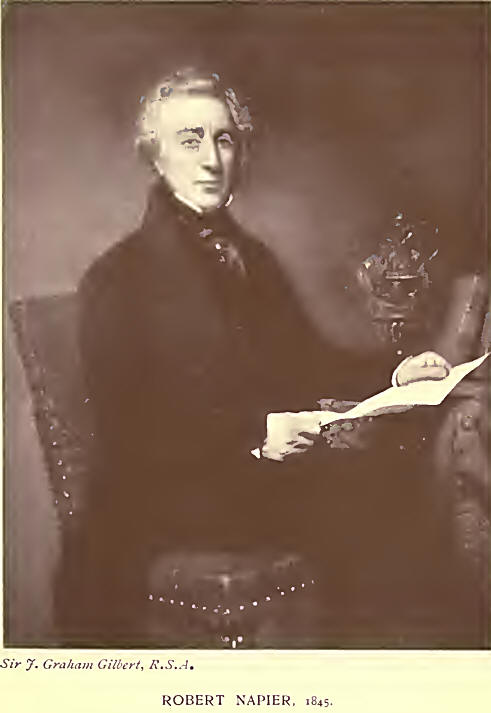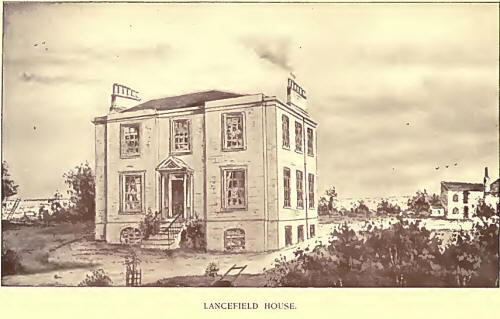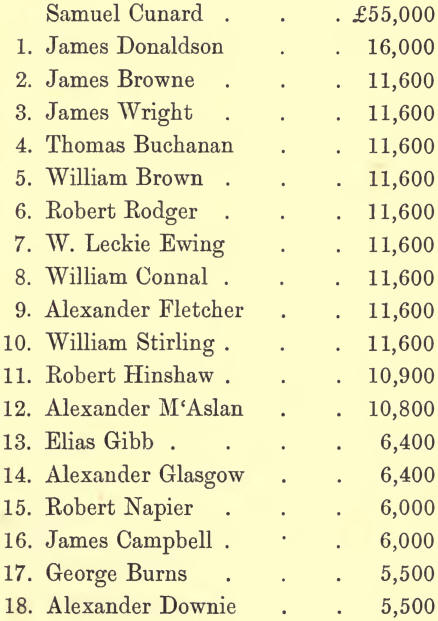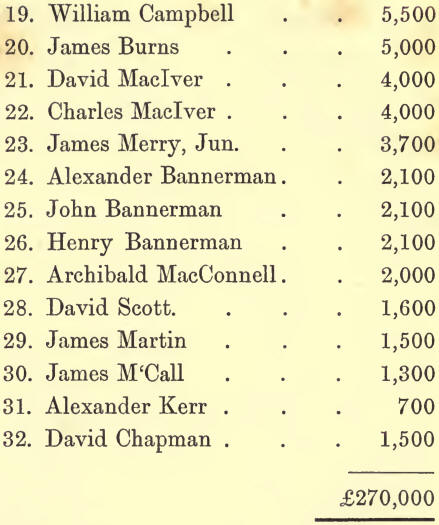|
We now come to one of the most important events in
Napier’s career — the founding of the celebrated Cunard Company. In
the inception of this enterprise the leading role was taken by him,
and we purpose going into this matter somewhat fully in the light of
the documentary evidence still extant.
In the early ’Thirties, about the time Robert Napier
was expressing his opinions on the practicability of regular steam communication between the two continents, the same
subject was being considered from a different point of view by a
prominent Canadian, Mr Samuel Cunard, whose attention was directed
to the matter by the successful trans-Atlantic passage made by the
small Quebec-built steamer Royal William already referred to. Cunard
was descended from a family of Pilgrim Fathers who had emigrated to
America in the early part of the seventeenth century and settled
in Philadelphia. When the United States declared their independence,
the Cunard family was loyal to its British traditions, and removed
to Halifax, where Samuel was born in 1788.
After serving an apprenticeship in a merchant's
office he obtained a partnership in a Boston shipping firm, which
conducted a service between Halifax and England, employing on the
trade “tublike” vessels widely known as “coffins,” from the fact
that several of them foundered in the stormy waves of the Atlantic.

The good passages made in the beginning of 1838 by
the Sirius and Great Western, and the efforts that were being put
forth by the British and American Steam Navigation Company to
establish regular communication, stimulated Cunard to endeavour to
make his dream of an Atlantic postal service a reality. He was not
unknown to the Admiralty, as he had already conducted a mail service
between Newfoundland and Bermuda in a manner that satisfied the
British Government.
In the end of 1838 he obtained a provisional Atlantic
mail contract, and set out for England to take the necessary steps
for fulfilling it.
Cunard was agent in Halifax for the East India
Company, and on his arrival in London he consulted the secretary of
the Company, Mr James C. Melvill, regarding the building of steamers
for the proposed service. Mr Melvill was on intimate terms with
Robert Napier, who had supplied his Company with the Berenice and
other vessels, and he strongly advised Cunard to put himself in
Napier’s hands.
Accordingly, on 25th February 1839, we find that
Cunard formally opened negotiations through his agents, Messrs
William Kidston & Sons, of Glasgow, writing to them as follows :—
Piccadilly, 25th February 1839.
Dear Sirs,—I shall require one or two steamboats of
300 horse-power and about 800 tons. I am told that Messrs Wood
& Napier are highly respectable builders, and likely to be enabled
to fulfil any engagement they may enter into. Will you be so good as
to ask them the probable sum for which they would engage to furnish
me with these boats in all respects ready for sea in twelve months
from this time? I am told that the London is a fine vessel, and
about the description of vessel that I might require; but I have not
seen her. I shall want these vessels to be of the very best
description, and to pass a thorough inspection and examination of
the Admiralty. I want a plain and comfortable boat, not the least
unnecessary expense for show. I prefer plain work in the cabin, and
it will save a large amount in the cost. If I find these gentlemen
are likely to meet my wishes, I will immediately proceed to Glasgow
and make the necessary arrangements with them. I shall also require
two or three boats of 150 horse-power: perhaps they will say the
probable cost of a boat of this latter size, complete for sea, with
a plain cabin, &c., &c. S. Cunard,
At the General Mining Association, Ludgate Hill.
Messrs W. Kidston & Sons.
Possibly Cunard may have been acquainted with the
nature of Napier’s proposals for Atlantic steamers; at any rate, it
is to be noted that the size and power of the boats he mentions are
exactly those fixed on by Napier in his letter, written in 1833, to
Mr Patrick Wallace as the minimum he would recommend.
To Messrs Kidston’s inquiry Napier replied at once :—
“Vulcan Foundry, 28th February 1839.
“Gentlemen,—In reply to your inquiry as to whether it
is my practice to contract and supply companies with steam-vessels
finished and completed ready for sea, and whether I am at present in
a position to undertake the construction and delivery of two or more
vessels so as to have them ready in twelve months from this date,
and the cost of steam-vessels about 800 tons and 300 horse-power, it
has been for many years past my practice to contract with companies
to supply them with steam-vessels ready for sea.
“In this way I supplied the Dundee Shipping Company
(George Duncan, Esq., Chairman) with three steam-vessels — the
Dundee, Perth, and London; the Inverness Shipping Company (Thomas
Davidson, Esq., Findhorn, Manager) with the Duchess of
Sutherland; the Aberdeen & Leith Shipping Company (Robert Mitchell,
Esq., Manager) with two vessels, the Sovereign and Duke of
Richmond; the East India Company (James Melvill, Esq., Secretary)
with one vessel, the Berenice ; the Isle of Man Steam-Packet Company
with three vessels; the Londonderry Steam-Packet Company with three;
the Belfast Company, Glasgow, with three; the City of Glasgow
Steam-Packet Company with the John Wood, Vulcan, City of
Glasgow, and a new vessel at present building for them. I also
supplied Thomas Assheton Smith, Esq., with three vessels—the Menai,
Glow-worm, and Fire King. To any of these parties you are at full
liberty to apply in order to ascertain the manner I fulfilled my
contracts for these vessels.
“From the great accommodation I have for doing work,
I could at present undertake to build and finish in twelve months
two or more steam-vessels, were I favoured with the order soon. The
cost of these vessels depends on so many different things that it is
hardly possible to name a price for them without knowing more about
them than you have communicated to me. I have done them as low as
£35 per ton of total measurement of the vessel, and I have got above
£50 per ton for some others. I may, however, state that good
vessels, warranted to stand any inspection and give entire
satisfaction both as to the vessel and machinery, cannot be done for
less than from £40 to £42 per ton,—this for the vessel ready for
sea, with cabins, sails, rigging, anchors, cables, &c.

“If your friend is really in want of vessels I shall
be happy to go to London and meet him, and I have no doubt but that
we would in a very short time understand one another.—Your most
obedient servant, R. Napier.
“Messrs W. Kidston & Sons.”
Cunard, on receipt of this letter, thought his best
course was to go to Glasgow to see Napier with the intention of
arranging the contract; and accordingly early in March a meeting
took place at Lance-field House. What then transpired can be best
told in Napier’s own words, in a letter written on 28th January 1841
to Messrs J. & G. Burns, as Messrs Burns’ firm was then styled.
“As there are some things connected with these
vessels that may not be known to you and the other owners so well as
to the Honourable S. Cunard and myself, I hope you will excuse me
making a few explanations — viz. : The first application that was
made to me about these vessels was through Messrs William Kidston
& Sons, and on the 28th February 1839 I wrote them a letter for the
information of Mr Cunard, and stated that vessels warranted to stand
inspection cannot be done for less than £40 to £42 per ton. Some
short time after this Mr Cunard came to Glasgow and waited upon me
at my house with specifications, &c., for vessels of 800 tons and
300 horse-power, for which he wished an offer from me, to be
finished in a plain substantial manner; and seeing that he was
prepared at once to give me an order if my terms pleased him, I at
once said at the rate of £40 per ton. His reply was that he
considered it fair and reasonable, but as he had three vessels all
of one size (and that similar to what I had in hands for the City of
Glasgow Steam-Packet Company), he said if I took £30,000 for each of
the vessels, he would give me the order before he left me. This I
agreed to as per the missive letter sent you, accepted and signed by
Mr Cunard.”
This was the first arrangement for the Halifax
steamers, and it will be observed that it was completed at the first
meeting that took place between Mr Cunard and Napier.
Business requiring his attention in London, Mr Cunard
at once went south, leaving instructions to get copies of plans and
specifications ready for his approval. He returned to Glasgow for
this purpose about the 12th March. During his absence, however,
Napier had been reflecting on the whole problem, and had come to the
conclusion that unless the vessels were made larger they would not
be successful. He urged Cunard very strongly to increase the
dimensions, but he was most reluctant to give his consent, as the
expense alarmed him. Napier, on the other hand, dreaded failure ;
and the course he adopted to avert this can best be told in his own
words, taken from the letter we have already-quoted.
“I said to Mr Cunard that if he paid for the
alteration of the vessel and work connected therewith, which I
thought, if properly gone about, might be done for the above sum
(£2000), that I would then make him a present of all my part of the
work for the enlarged size of vessels. He at once saw the great
benefit to be derived to him from this arrangement, and accordingly
the contract of 18th March 1839 was drawn out.”
This contract stipulated for steamers of 960 tons,
with engines of 375 N.H.P., and the price was fixed at £32,000 for
each vessel.
The second arrangement was not such a favourable one
for the engineer as the first one. Napier, however, was always very
jealous of his reputation, and was prepared to make sacrifices to
maintain it, and hence his proposal to Cunard. To quote his own
words, “ He felt that if these small vessels did not succeed they
would do him more injury in character than any money he could gain
would benefit him.” A formal contract was now entered into and
signed on the 18th March 1839, the sole contracting parties being
Samuel Cunard and Robert Napier. The same day Cunard left for
London, and the first stage of the negotiations was reached. Napier
next day wrote a letter of thanks to his friend Melvill.
“Glasgow, 19£A March 1839.
“My dear Sir,—Yesterday, after signing the contract
in a formal manner, Mr Cunard left this per mail for London.
“It being customary in our Scotch contracts to name
arbiters to settle any differences that may arise between the
contracting parties, I took the liberty of naming you to Mr Cunard.
To this he agreed at once.
“I hope you will excuse this liberty on the faith you
are not to be troubled further than coming down, I trust, and taking
a sail up in one of the vessels to London.
“I am of opinion Mr Cunard has got a good contract,
and that he will make a good thing of it. From the frank offhand
manner in which he contracted with me, I have given him the vessels
cheap, and I am certain they will be good and very strong ships.
“I can only again repeat my obligations to you for
your kindness, and am, dear Sir, yours faithfully, R. Napier.
“James C. Melvill, Esq.,
Secretary, The Honourable East India Company.”
When Cunard arrived in London he at once put himself
in communication with the Government, and informed them what he had
arranged. On the 21st March he wrote to Napier—
The Admiralty and Treasury are highly pleased with
the size of the boats. I have given credit where it is due to you
and Mr Wood. I have pledged myself that they shall be the finest and
best boats ever built in this country.
You have no idea of the prejudice of some of our
English builders. I have had several offers from Liverpool and this
place; and when I have replied that I have contracted in Scotland
they invariably say, “ You will neither have substantial work nor
completed in time.” The Admiralty agree with me in opinion that the
boats will be as good as if built in this country, and I have
assured them you will keep to time.
Again on the 25th March he wrote :—
Am I not right in saying you are to give me
everything upon the best and most improved plan.
On 27th March Napier replied to Cunard :—
“I am in receipt of your esteemed letters of 21st and
25th current. I was quite prepared for your being beset with all the
schemers of every description in the country and in this stage of
the business, and think it right to state that I cannot and will not
admit of anything being done or introduced into these engines but
what I am satisfied with is sound and good. In a word, I shall not
pay the least attention to any scheme but that I have fixed
on—viz., ‘your engines will be made similar in construction to those
I am at present making to the Admiralty.’
“Hall’s condensers cannot be allowed if it was on no
other ground but that of time, as it would be actually impossible
for me to meet your time and adopt his plan. Every solid and known
improvement that I am made acquainted with shall be adopted by me,
but no patent plans.
“I am sorry that some of the English tradesmen should
indulge in speaking ill of their competitors in Scotland. I shall
not follow their example, having hitherto made it my practice to let
deeds, and not words, prove who is right or wrong. At present I
shall not say more than court comparison of my work with any other
in the kingdom, only let it be done by honest and competent men.”
Now at this time the British Queen was being finished
by Napier. This vessel, and her sister ship the President^ were very
much larger and finer steamers than those Mr Cunard had ordered; and
in view of this fact and the letters he was receiving from his
customer, Napier suggested the desirability of still further
increasing the vessels. To this proposal Cunard turned a deaf ear,
as he was unwilling to incur further expense, more especially as the
Admiralty and Treasury had expressed themselves satisfied.
Mentioning the matter to Mr Melvill, and recounting
his Glasgow experience, Cunard stated incidentally that the
Admiralty were pleased with the ships, but that Napier considered
them still too small, and was always proposing larger boats. Mr
Melvill expressed the opinion that to ensure success the adoption of
Napier’s views was imperative, as he was the great authority on
steam navigation, and knew much more about the subject than the
Admiralty.
Cunard rejoined that while he valued Napier’s advice,
larger boats meant more money, which he could not afford, as he had
been disappointed in getting his stock taken up ; and even the offer
of the agency to his correspondents, Messrs Kidston, had not induced
them to participate in his enterprise.
Melvill strongly advised him to go north again and
place the matter fully before Napier, as he thought he would be able
to assist him in his difficulties, and Cunard at once adopted this
suggestion.
Another meeting took place at Lance-field House, at
which Mr Cunard explained the position, and Napier, after
consideration, said he thought he could help him in his difficulty.
As already mentioned, he was one of the founders of
the City of Glasgow Steam-Packet Company, whose steamers plied to
Liverpool. The Company was managed in Glasgow by Messrs Thomson
& Mac-Connell, and in Liverpool by Napier’s friend Mr David Maclver.
Thinking that those interested in local shipping
would risk something in an ocean venture, he sounded his friends and
other co-shareholders, including Mr James Donaldson, a wealthy
cotton broker. They responded enthusiastically, Donaldson personally
undertaking to subscribe £16,000.
Having succeeded so far, he now approached Mr George
Burns, who had fallen heir to the Belfast trade which the Napiers
originated, and who, along with Mr Martin, was agent for a line of
steamers trading to Liverpool.
Napier knew Mr Burns as an excellent business man and
capable agent, and he suggested that he mio;ht obtain for him the
agency of Cunard’s steamers if he could assist in raising a part of
the capital.
Burns, after due consideration, fell in with the
proposal, and as prospective agent he propounded the scheme to
Napier’s friends and his own shareholders.
As stated in the life of Sir George Burns, the amount
aimed at (£270,000) was at once subscribed, and the new copartnery
was called the British & North American Royal Mail Steam-Packet
Company.
The original subscribers were as under:—


It will be observed Mr Cunard had by far the largest
holding in the Company, and the other shares were divided pretty
equally between Mr Napier and his friends and Mr Burns and those
whom he induced to join the enterprise. Though Mr Burns personally
did not subscribe a great amount, he obtained through
Mr Napier the agency, which was by far the most
lucrative position in the venture. Napier, however, recommended
Burns not for his wealth, but for his commercial ability, and the
future history of the Company justified his selection.
The management of the steamers, including the
appointment of officers and crew, was entrusted to Napier's old
friends, Messrs Maclver of Liverpool, who performed their part in
the most efficient manner.
The newly constituted Company adopted Mr Cunard’s
contract as a basis. The number of the vessels was increased to
four, and they were made larger and more efficient in the way Napier
desired ; in fact, everything was left to him, and his mark is still
to be seen in the red funnel, which had hitherto distinguished the
steamers he was interested in.
In addition to increasing the dimensions, the ships
were filled up solid in the bows between the timbers with strong
beams and knees, and water-tight bulkheads were fitted to prevent
accident should the vessels strike ice. They also were doubled all
over with hardwood planks, and strong iron straps were fitted to
prevent straining. The cabin accommodation was made much more
luxurious than originally contemplated, and perhaps this was
necessary, as the fare was 38 guineas.
The names of the four vessels
werethe Acadia, Britannia, Caledonia, and Columbia, — the Acadia,
built by Wood, being the “pattern card.” The first to sail was
the Britannia, commanded by Captain Woodruff, which started from
Liverpool on 4th July 1840, and arrived in Boston a fortnight later.
On her outward passage she was retarded by westerly winds, but
sailing' for home in the ensuing month, she made the return voyage
in a little over ten days, her best day’s steaming being 280 knots.

Such was the part played by Napier at the start of
this celebrated Company; and from the preceding narrative it will be
apparent that it was mainly through his co - operation with Mr
Cunard, first in enabling the latter to get his plans into practical
shape, and then in providing a series of steamships unrivalled in
their time, that immediate success was attained.
It was the confidence reposed in Robert Napier, in
the man and in his work, that secured most of the capital necessary
(outside of Mr Cunard’s contribution) to found the Company on an
adequate basis, and it was undoubtedly the excellence and uniform
success of the machinery and vessels he supplied that gained for the
British and North American Company that support from the commercial
world which led to its remarkable prosperity, and enabled it to
emerge triumphant from its memorable contest with the Collins Line.
“Napier was the practical head and hand of the Cunard
Company in its early days, without which it might have proved a less
successful venture in the vast field of enterprise it so long
monopolised.”
By those possessed of the requisite knowledge, Mr
Napier’s energy, organising skill, and engineering ability have been
cordially recognised as the foundation from which the Cunard Company
took its beginning, but by no one was the importance of his services
acknowledged with greater freedom than by Mr Cunard himself. Between
Cunard and Napier there existed a lifelong friendship. At the
latter’s request he sat for his portrait, which was presented to his
daughter, Miss Cunard, with whose letter of thanks as reflecting
these sentiments we conclude.
Bush Hill, Edmonton, Jan. 17,1860. My dear Sir,—The
portrait of my father that you have been so very kind as to present
to me
has now been hung up in the dining-room at Bush Hill,
and, although personally a stranger to you, I hope you will allow me
to express my sincere thanks for a gift that must be valuable to me
for its own sake, as well as for the sake of the donor, whose name
has been familiar to me from early childhood in connection with much
that I have heard of science and natural energy and talent.
Your present will always silently remind me of your
generosity, which will at all times be remembered with pleasant
gratitude.—Believe me, my dear Sir, yours truly and obliged,
Elizabeth Cunard.
R. Napier, Esq. |

